In the 1960s, Minnelli was unable to find a worthy project to direct. Metro encouraged him to accept offers from other studios, which further offended him. Out of desperation, Minnelli accepted Fox’s offer to direct Goodbye, Charlie, George Axelrod’s stage farce about reincarnation in a Malibu beach house.
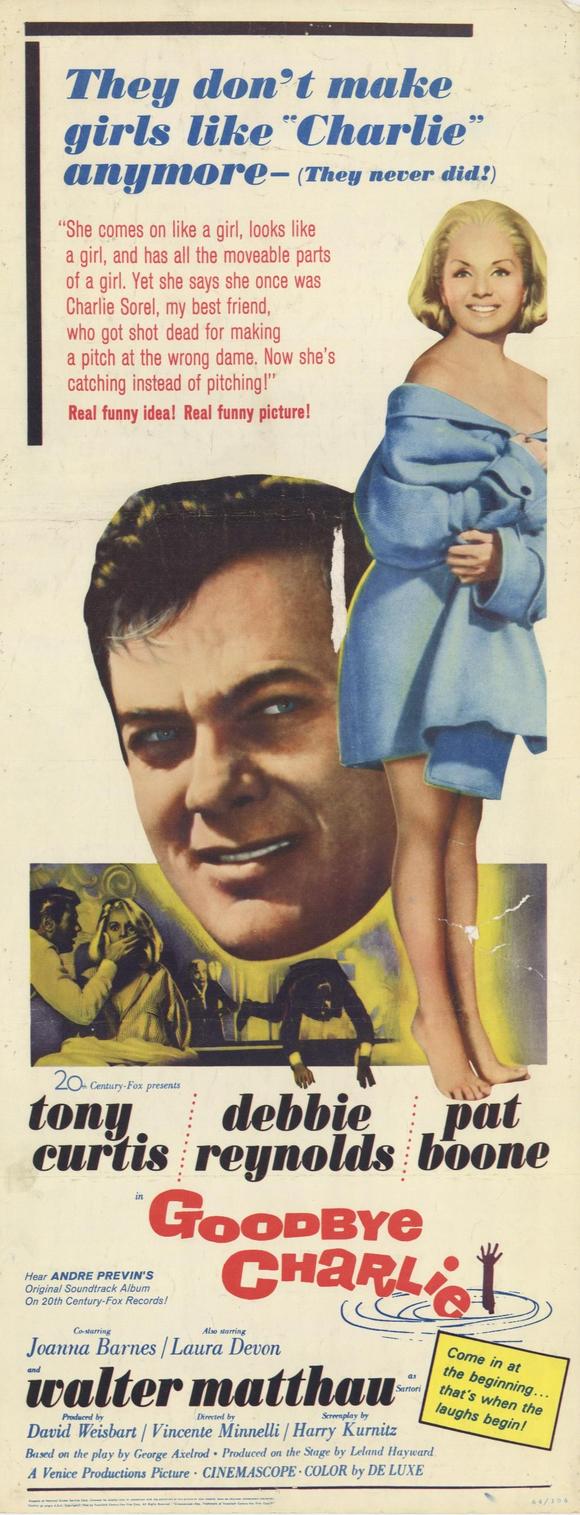
For some reason, Minnelli took an unnecessarily long time, full five months, from January to June of 1964, to prepare and shoot Goodbye, Charley, which was perceived in Hollywood as sign of his declining faculties.
The Broadway play ran for only three months due to the poor marquee value of Lauren Bacall, who was making her stage debut. Fox snared the play, hoping to shape it to the talents of Marilyn Monroe, who had triumphed in Axelrod’s other known comedy, Seven Year Itch, directed by Billy Wilder. Initially, Minnelli was excited to work with Monroe, Hollywood’s hottest star at the time. However, by the time Goodbye, Charley went into production, Monroe had been dead for a year, and her last film, Something’s Gotta Give, under Cukor’s helm, was never completed or released.
Reluctantly, Fox next turned to Debbie Reynolds, who enjoyed sudden popularity after The Unsinkable Molly Brown became the sleeper hit of 1963, for which she earned her first and only Oscar nomination. Minnelli, however, had serious doubts about his leading lady. On stage, Lauren Bacall brought a certain androgynous quality to her part. She played a Hollywood Don Juan who’s killed off by an outraged hubby (before the play opens), and rematerializes to the incongruous form of the cute woman he’s spent his life seducing. Minnelli could not see Reynolds in a bizarre story that was ahead of its times in terms of sexual politics.
It was ironic that Minnelli’s first movie away from Metro found him with Debbie Ryenolds, because he had refused to work with her at Metro, where both were under contract for decades. Minnelli perceived Reynolds as too crass and uneducated, lacking finesse. Fox, however, stood firm. Too eager to work to quibble, Minnelli acquiesced and bore grudges against Reynolds, quietly.
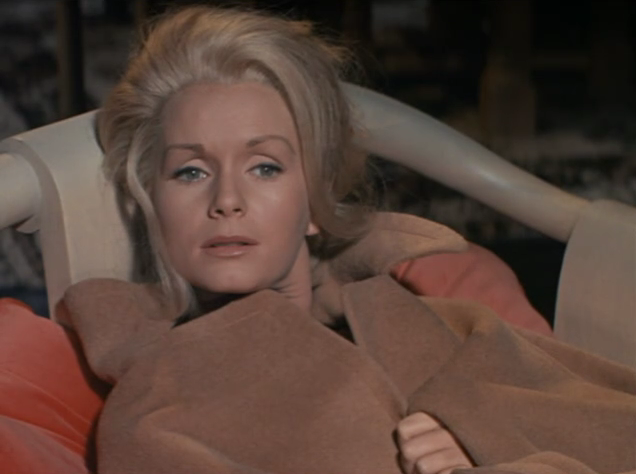
Unbeknownst to Minnelli, Reynolds also regretted her commitment to the film. She perceived it as a one-joke story, describing it as “a tale of a dead man comes back with the heart and mind of a reincarnated woman.” However, Reynolds wanted to work with Minnelli, failing to realize the troubles she would have with her fussy director.
The part of Charlie’s randy crony went to Tony Curtis, who had worked successfully with Debbie Reynolds on The Rat Race. Unlike Reynolds, Minnelli liked Curtis, and the two men enjoyed a nice relationship on the set.
The contrived farce did not inspire Minnelli on any level. He tried to recreate the distinctive Metro ambience on the Fox lot by surrounding himself with long-time colleagues: Cameraman Milton Krasner, composer Andre Previn, costumer Helen Rose, and set decorator Keogh Gleason. Most of all, he relied on art director Jack Martin Smith, who had designed most of Minnelli’s Metro films.
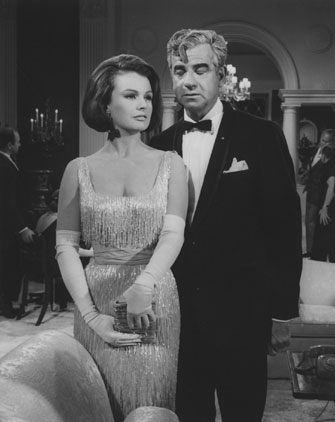
Apart from few location shots in Malibu, the film was made on the back lot, which underscored the tale’s claustrophobic staginess. In fact, no less than half of the yarn takes place on a single set, Charlie’s glitzy bachelor lair.
In the past, Minnelli was able to insert some wit into the simplest of his comedies, but Goodbye, Charlie suffers from a stiff script (with only a few acerbic lines) and the kind of morality that was cynical without being poignant. Axelrod’s point, that Charlie’s fate represents a punishment for his sexual exploits, was a transgressive enough theme to appeal to Minnelli’s sensibility. The hero says at one point, “It’s as though I’d been a gourmet all my life, and suddenly I’m a lamb chop.” The wit never rose about that level. The notions of bisexuality, effeminate men, and masculine women had always intrigued Minnelli as an artist and a man, since he himself combined those attributes in equal measure.
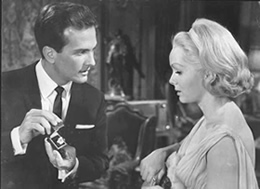
As he showed in The Seven Year Itch and Will Success Spoil, anatomy of the all-American male was Axelrod’s favorite theme. But in this work, there was a thin line between Axelrod’s take on the opposite sex and that of the saps he satirized.
Due to Axelrod’s cartoonish idea of femininity, symbolized by tears and beauty parlors, Curtis’s gradual transformation into a woman is not charming as it should have been. Worse, as his new self, Charlie is even duller than the male he was. Posing as his own widow, the hero tries to blackmail his former bedmates.
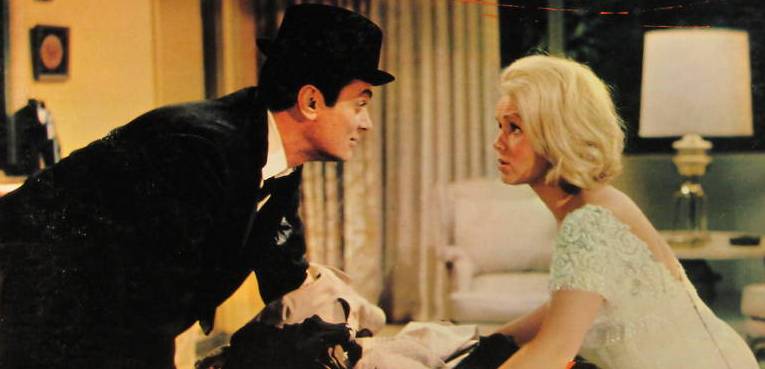
While screenwriter Harry Kurnitz preserved the play’s spirit, he added some new wisecracks. “I don’t have to go see Brigitte Bardot movies anymore,” muses Charlie, “I can just stay home and pull down the shades.” Kurnitz tried to open up the play by introducing two characters enamored of the new Charlie: A naïve, rich Mama Boy (played by the singer Pat Boone), and the unseen trigger-happy producer (Walter Matthau), who had dispatched the hero before the story begins.
Fortunately, the Beverly Hills setting brings the movie closer to Minnelli’s familiar territory. Like The Bad and the Beautiful, the movie contains allusions to Hollywood lore, but this time out played for broad laughs, not intensely emotional melodrama. The scene of Charlie being shot in the pants while on a yacht recalls of course the historical incident of Thomas Ince scandal of the 1920s (that Peter Bogdanvich’s filmed in 2001 as The Cat’s Meou.
The deadpan agent Crafty (Martin Gabel) is a clone of dealmaker Irvin “Swifty” Lazar, and the movie’s Hungarian mogul, Sir Leopold Sartori (Walter Matthau), resembled Sir Alexander Korda, the noted Hungarian-British producer-director, who helmed That Hamilton Woman and produced The Tales of Hoffman and Olivier’s Richard III, among many credits.
In this picture again, Minnelli skewers the lifestyles of the rich and famous. Joanna Barnes and Ellen McRae (former name of Ellen Burstyn’s) play poisonous Hollywood wives with hilarious wardrobes to match. Whenever the secondary characters are onscreen, Goodbye, Charlie shows some of Minnelli’s brio; the rest is just crass.
Two sequences were meant to elevate the film above the routine. The opening orgy is sumptuous stuff, a kind of Via Veneto-American style that Minnelli had staged in Two Weeks in Another Town, but it was excised from the final cut. In the second, Minnelli moves the camera past a drugging starlet toward the stateroom where Charlie disrobes a redhead.
Minnelli shows his taste for kitsch when Charlie visits Rodeo Drive, a West Coast, all-female variation of the Park Avenue retreat that was seen in the opening sequence of Cukor’s The Women. Delighted to be on an expansive set, Minnelli uses his camera with a droll flourish to record a place flanked by blue fiascoes, with languid women dangling their toes in the fountains while gossiping about this and that.
The movie’s vulgar crassness, however, upstages Minnelli’s parodic efforts. In the cheapest gag, the still male-at-heart heroine gets into the spirit of her new surroundings by goosing the nearest available fanny. With her notorious tomboy’s playfulness and aggressiveness, Reynolds’ pat is more like a slug.
In The Reluctant Debutante, Minnelli showed some verve despite slim text and restrictive set. But in Goodbye, Charlie, he doesn’t care much. Curtis and Reynolds spend a good deal of time onscreen trading jokes in front of a back-projected seascape. For long stretches, it feels as if Minnelli retreats behind the camera, letting his stars do what comes naturally to them, without any interference or guidance.
As the expatriate novelist, Curtis belts out his repartee in a pale imitation of Cary Grant, though not as proficient and dead-on as his impersonation of Grant in Some Like It Hot. For such a crude man, the late Charlie still has too good a taste in paintings, which reflected Minnelli’s aesthetics rather than that of his characters.
Except for Stanley Kubrick, who had directed Curtis in Spartacus, Minnelli was the most demanding director the actor had worked with. Curtis later recalled: “Minnelli was obsessed with tiny little details–everything had to match. He was always fidgeting with the set. He always wanted everything to look opulent and rich.” Curtis also recalled, that “Minnelli and Ellen Burstyn (billed in the film as Ellen McRae) kicked the shit out of each other. They hated each other.”
Compared to the indefatigably energetic Reynolds, Curtis is relatively subdued. Dressed in oversized pajamas, Reynolds comes across as an aggressive femme, with her pastel paint and curvy costumes. Minnelli saw his main task in this picture to restrain Reynolds’ excessive energy. He was always nudging Debbie to do things differently, a little more delicately. One day, Debbie came on the set and said quietly, “Good morning, everybody.” Then she looked over and said to her director, “How was that for you, Vincente, or should I try again?” It was very much in the spirit of the joke that Judy had told on the set of Meet Me in St. Louis about Minnelli and his one-line actor.
Goodbye, Charlie became one of Minnelli’s last and least impressive efforts, solely driven by his determination to keep working, without being able to adapt to the changing times. The press dismissed Goodbye, Charlie as just another verbose and stillborn farce.
The movie opened in New York in November 1964, playing only three blocks away from the theater where My Fair Lady had started its long triumphant engagement. While visiting New York City, Minnelli would walk around the block to avoid seeing the lines of people waiting to get into a screening of My Fair Lady. It was too painful to observe. If it were not for his damn wife, it could have been his picture—and a better one.










